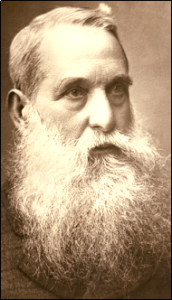Registered with the Registrar of Newspapers for India under R.N.I 53640/91
Vol. XXVIII No. 12, October 1-15, 2018
He recorded South India for Government
by Dr. A. Raman anant@raman.id.au

Linnaeus Tripe.
Linnaeus Tripe’s life as a photographer peaked when he served as the Government Photographer in Madras, between 1857 and 1860.
Linnaeus was born to Cornelius and Mary Tripe of Plymouth Dock, Devon (now, Davenport) in 1822. He came to India, preferring a career overseas, and enlisted as an ensign in the Madras army (specifically the Madras Native Infantry) in 1839. He was promoted as a lieutenant in 1840 and as a captain in 1851. He got interested in photography when he was training as an officer cadet. His proficiency in photography impressed the government, and consequently he was appointed as the official photographer at the British Mission to the Court of Ava (Burma). What necessitated the creation of a new position of a photographer at that time?
The Second Anglo-Burmese war of 1852 ended with the British annexation of Pegu and occupation of Rangoon. Dalhousie, the Governor General in Calcutta, required King Mindon Min of Burma to sign a treaty recognising annexation. Government of India established a Mission office in Upper Burma in 1855 with Arthur Phayre as the Commissioner of Pegu Province and Henry Yule as the Secretary of the Mission. Further to a diplomatic objective, the Mission was keen on extracting detailed information on this region. Dalhousie considered that a visual record of the journey would convey a better idea of the natural features of Burma than a written report and that “sketches of the people and of cities and palaces would give a life and interest to the future report of the Mission”. Colesworthy Grant, an artist in Calcutta was selected to go the Pegu Mission and create artworks of the region. Since photographs were becoming popular, Linnaeus Tripe, who by then showed talent in taking photographs, also was commissioned as the official photographer by Dalhousie.
Tripe hardly spent 40 days in Upper Burma, because of health setbacks. Nonetheless, during his stay in Upper Burma, he travelled on the Irrawaddy to Amarapurra, and made close to 200 lightly albumenised salt prints from large wax-paper negatives (10″ x 13″; 260 x 345 mm). On return to India, he was able to create a portfolio of selected 120 calotype prints of Upper Burma. Some of Tripe’s images made in Burma can be viewed in the website: https://www.bonhams.com/ auctions/ 24634/lot/116/. No document indicates the type of a camera Tripe may have used. Most probably it was a large ‘daguerreotype camera’ which was built using wood (or metal) with bellows from the lens to the glass plate. Alternately, it could have been custom-built.
At the Madras Exhibition of Raw products, Arts and Manufacture of South India 1855, in the section ‘Photography, Lithography, Painting, etc.’ Tripe won the first class medal for his photographs of the temple towers and precincts of Halebedu and Belur (Photographic view of the temple of Hallebede and Baelloor), which were created scientifically and imaginatively. Alexander Hunter, the Founder-President of the Madras Photographic Society (MPS), established in 1857, comments on the items submitted by Tripe at the Madras Exhibition (1855),
” … the best series of photographic views on paper is exhibited by Captain Tripe. It consists of 68 large pictures 21″ x 14″, taken from the Jain temples and ruins of Hallebede and Baelloor in Mysore. The majority of these are clear, sharp, and well defined in details, proving that great care has been taken to obtain the correct focus.”
Andrew Charles Brisbane Neill attached to the Madras Medical Establishment was another avid photographer of Tripe’s time. Neill accompanied Tripe to Halebedu and Belur.
Tripe used the then state-of-the-art ‘calotype process’ (also known as Talbotype) first developed by William Henry Fox Talbot. The calotype process involved the treatment of a quality paper with light-sensitive silver compounds before exposure in the camera. The realised image was then developed using the sensitiser, viz., gallo-nitrate of silver (a compound consisting of silver nitrate, acetic acid, gallic acid, and distilled water) and fixed. The calotype negative process underwent improvements in the 1850s and photographers applied warm wax to the developed negative to improve printing transparency and reduce visibility of paper fibres, which was used by Tripe. We cannot say that all of his photographs were the best, but given the circumstances and technicalities then available, their compositions were good.
Tripe taught the calotype process to the employees of the Public Works Department and the collodion process to pupils at the Madras School of Industrial Arts. He was a member of the Madras Photographic Society and explained periodically the then new advancements made in photography to other members of MPS.
Tripe’s assignment as the Government Photographer ended in 1859. He sold his cameras and other instruments to a Captain Wincon and P. Orr. He gave away the furniture, chemicals, and accessories to the MPS and returned to the 12th Madras Native Infantry. He retired in 1875 as a Colonel. No records exist whether he made any photographs between 1860 and 1875. He returned to Devon and died in 1902.

